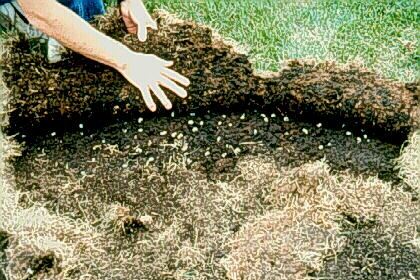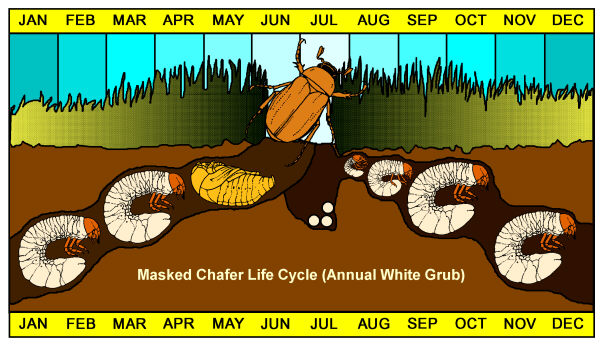How Can We Help?
Treating your Lawn & Garden for White Grubs

Treating Your Lawn and Garden for White Grubs
European Chafers, June Bugs and Japanese Beetles are most destructive during their growing grub cycle before pupating into a beetle to reproduce. All three create the same damage to turf and garden plant roots which is shown as browning turf or dieback in shrubs due to damaged root systems created from the crewing activity from white grubs.

There are a few different ways to treat your lawn and garden for white grubs, one way would be to drench your soils with nematodes; a microscopic parasitic soil worm.

Nematodes are most effective when applied to grubs that are in the first instar of their grub stage. (Instar refers to the first larval stage after hatching from an egg). These microscopic parasitic worms burrow themselves inside the bodies of white grubs. Adult nematodes lay eggs within the grub body and use it as a food source. This cycle continues if there are white grubs to feed on.

Since white grubs are most vulnerable in the first instar, the most effective treatment is when the adult population had mated and laid eggs in the soil. Soon after this has occurred, apply nematodes.
It is important to read the instructions provided with the nematodes you have purchased, keep in mind the following tips. The best time to apply nematodes is when the soil has been saturated with rain or a good amount of irrigation. It is easiest for nematodes to migrate through the soil to the next white grub when the soil is moist. Another recommendation is that nematodes be applied on an overcast day or at dusk as nematodes are organisms that don’t fare well when exposed to UV rays.
If you have to take a break from applications for any length of time, before continuing; give your nematode solution a gentle stir before as they will settle to the bottom of your container or sprayer. You can choose to use a sprayer applicator that can be found at reputable garden centres, just be sure that there isn’t a screen or filter present. The filter or screen will harm their delicate bodies as they are pushed through the sprayer. Another method of application is to fill a 5 gallon pail with lukewarm water and stir the nematodes in gently. Go around to the effected or all areas of your property and pour the mixture out using a pitcher or watering can. The nematodes will find the way to their food source.
Since nematodes don’t overwinter in our climate, you will have to reapply every year to gain effective control if you are experiencing damage from grubs in your lawn or garden.

You can also over seed your lawn in the spring and fall with Regenerating Perennial Rye. Turf grass varieties such as this, have a thicker root system which is less desirable to grubs and regenerates itself faster from damage than other turf types.
Applying a turf fertilizer in the spring or fall will help establish root growth and aid in recovery after grub damage. Consider using a blend like 8-32-16.
Placing traps for adult beetles does aid in removing a portion of the adult population that would have otherwise laid eggs in your lawn and garden. Although unsightly, they do aid minimizing the issue for the following season.
